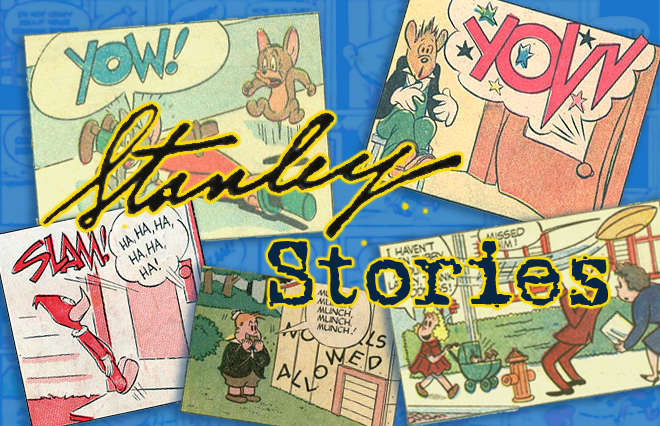I hope I'm not over-doing the 1940s funny animal stuff on this blog. As it represents (a) a substantial chunk of John Stanley's 1940s work and (b) is not likely to be extensively reprinted [if all] anytime soon, I feel it merits study here.
As well, it's fascinating to see Stanley work out some of his major themes in these anonymous licensed-character pieces. No one had high expectations for these stories. The editors had standards, to be sure, and exercised them. But, bottom line: this was a business. Someone had to fill the pages of these monthly comic books.
1940s New York was filled with comic book publishers. Many of them didn't give a hoot about what went on the pages of their publications. The actual stories were just a bothersome fact of life--a means to the end. If the writers and cartoonists shared this cynicism, and many apparently did, the end result was lifeless crud. It's why most so-called "golden age" comic book stories are so depressing and un-involving to 21st century readers.
We are fortunate that talented individuals such as Stanley, Carl Barks, Dan Noonan and Walt Kelly were the "someones" at Western/Dell. Because they enjoyed their work, and gave a s*** about what went on the pages (a concern shared and fostered by their editor, Oskar Lebeck), these stories surprise us, 60+ years later, with their intelligence and playfulness.
Today's offering was almost picked at random. I flipped through my stash of Stanley comix, in search of something different to post here. This story reached out and tagged me "it." This was, perhaps, due to its similarity to another 1940s Stanley funny animal piece with an overweight, sexually aggressive female character, which was the final of four stories in this Xmas post.
Stanley's funny animal stories generally feature sexually neutral male protagonists, who share a joyful domestic relationship--in which homestead, car and bed are their mutual property. Nothing deeper can be read into these relationships. They're childlike and innocent--even tho' the characters often display an incongruously adult sense of sarcasm and materialism (i.e., they desire cars, clothes and home appliances, rather than toys and cookies).
Stanley's "Oswald Rabbit" stories often push the boundaries of these seemingly neutral relationships. There seems to be a more intense connection between cuddly Oswald and his equally-plush buddy, Toby Bear than with Stanley's other odd couples.
Aspects of this intensely physical closeness surface in a few stories. Most notable is Stanley's 1945 masterpiece, "The Secret Six," in which the characters' relationship gets quite physical--by kids' comic book standards.
This story, from a late 1946 issue of New Funnies, shows the duo in a state of pre-pubescent confusion. Their carefree trip to an amusement park becomes an awkward, nightmarish exercise in social chaos.
What's funniest about this story is that nothing really happens in it, story-wise. The protagonists are put through physical paces in the story's climax (which reminds me of the finale of the 1950 film noir classic Woman on the Run). Otherwise, they just shamble along, with no goal, save for Toby's determination to not eat the wooden sticks of the apples-on-sticks he craves.
The female character is much less aggressive than Mabel, the mouse in that "Tom & Jerry" story I referenced earlier. She just happens to be there, and finds our heroes a convenient receptacle for her mis-guided affection. In Stanley's comedic world, these characters keep showing up, once they're established. They exist solely to cause problems for the protagonists.
In this case, Oswald and Toby allow themselves to be drawn in, out of childish curiosity. Toby has no idea what he's doing, or why he should even be doing it. Oswald acts as the voice of reason, but it's clear that his is also the viewpoint of a child. Neither of these fuzzly neuters know what they're getting into.
Later, the un-named woman reveals something of her inner world, when she cries out "Oh, I'm ALL alone!" (Aren't we all, at times, dearie?) As well, Stanley lets out one of his rare winks at the reader in this panel:
Like Carl Barks, John Stanley seldom trafficked in these fourth-wall busting moments. He seems to have gotten them out of his system in the 1940s. In a throwaway story like this, there are no great stakes to salvage, so why not reach out to the reader with a friendly little noodge?
Page 4 of the story is an early instance of Stanley's time-saving, usually narratively clever black panel routine. He would lean on this routine heavily in his Little Lulu comics. To his credit, he uses these cheater sequences to impart subtle comedic info to his readers. I'm sure the artists appreciated this opportunity to zone out at the drawing board, with the radio on, brushing in fragrant black ink to the accompaniment of a rattling metal fan.
This is an example of Stanley at his most average and unambitious--just having fun with someone else's characters, and finding a reasonably smart and amusing way to fill up nine pages in a monthly comic book. Unlike the pages of, say, a DC funny-animal book, these are still worth reading and studying, 64 years later.
POST-SCRIPT: I have had a number of attempted spam comments in recent weeks. Please don't waste time trying to sneak spam past me. I only post "clean" comments--ones that have actual human content in them. If you're just trying to get some spam generated, fugeddaboutit-- it's wasted effort. To repeat--I only accept comments with actual content. Got it?
Thanks to the people who do leave real comments here--they are greatly appreciated!











No comments:
Post a Comment